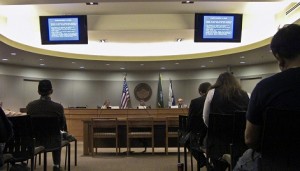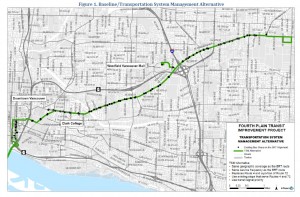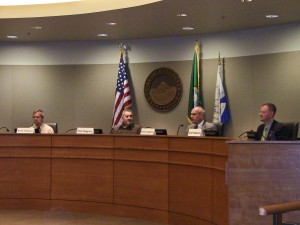As advertised, the C-Tran meeting on bus rapid transit for the Fourth Plain corridor was all about what the project could look like and not much else.
Sponsored by the Vancouver Planning Commission and facilitated by their Vice Chair Robert Haverkate, the meeting took place in the void left by the cancellations of both the Regional Transportation Council and the County Commissioners’ meeting.
The gathering at City Hall felt a little like Alcoholics Anonymous, admit you have a problem and yes, C-Tran freely admits they have a problem.C-Tran buses on Fourth Plain are running full, in fact, so full that they have standing room only and run behind schedule. Passengers with mobility issues were listed as leading causes of these delays as well as the increasing traffic on Fourth Plain.
“The environment slows you down and some customers slow you down,” said C-Tran’s Public Affairs Director Scott Patterson. “It can take a full five minutes to load a passenger with a wheel chair.”
According to meeting documents, the Federal Transit Administration (FTA) and C-Tran have agreed on an alternatives analysis process “to fairly and equitably identify, evaluate and select the Locally Preferred Alternative” to address these issues. In addition, C-Tran is looking for federal taxes and plans to mine dollars from the community by asking for a new tax on the November 2012 ballot. (Read: C-Tran board commits $300K for 2012 high capacity transit vote.)
Panelist Bryan Snodgrass, a land use planner for the city, drilled steadily through his presentation covering subarea history, “pulse points,” and action items. He stated that capital investment, job creation, access to businesses, expanding business exposure, safety and streetscape designs were prime topics the project wants to address.In 2007, the city adopted this subarea plan and overlay district with street-front development standards to promote “an active, attractive and safe streetscape.” Although, as earlier reported on COUV.COM, the fallout has stymied Fourth Plain businesses from expanding due to exorbitant fees (Business owner chafes at Fourth Plain code restrictions.)
Panelist Mark Maggiora, Executive Director, of the nonprofit Americans Building Community, weighed in on the overlay district saying, it was a “big wake-up call for number of businesses, when they learned the costs that they would be subjected to if they were to make any sort of business improvement.”
Some businesses have ‘limited appreciation’ of meetings
Mark Maggiora described the grassroots efforts of the business community along Fourth Plain to bring people into the area via a number of events. The work brought out a passion in many to improve the area. In 2011 he saw the need to do a better job of getting information about bus rapid transit to the merchants associations and individuals who owned businesses along Fourth Plain. The policies and decisions being discussed could both enhance the corridor as well as “challenge the viability of some of those businesses.”
Maggiora set out to encourage businesses to take leadership around developing more informal close knit relationships with existing business owners. “Primarily because many of them come from multi-cultural communities so they have a limited appreciation of the value of our culture’s approach to meetings all the time.”
To facilitate better communication – for those who do appreciate meetings – they held a “number of workshops” although one of the high profile businesses on Fourth Plain, namely DeWils, complained afterwards of the difficulty to be alerted even 24 hours in advance of those earlier meetings.
“We have yet to get any information on this,” said a frustrated Lynda Wilson after the meeting.
What is it – bus rapid transit?
Parsons Brinckerhoff, which reportedly is the recipient of $17 million for consulting on the Columbia River Light Rail Tolling project, sent Portland Planning Manager Stefano Viggiano to put the audience unfamiliar with bus rapid transit at ease. He said that today 70-80 communities are considering it, but “15-20 years ago not too many people in this country were talking about bus rapid transit.” He led the audience through a snazzy, six-minute video to represent how bus rapid transit could perform on the Fourth Plain corridor – dedicated bus lanes but fewer bus stops, signal lights that allow buses to “jump the queue” (get out in front of the other traffic), and he offered case studies from Everett, Rapid Ride in Seattle, and EMX in Eugene, Ore.
Basically, it’s a sleek looking, 60-foot, articulated bus that offers speed boarding, and it costs $1,000,000. That’s $1 million, not for the entire BRT system, but $1 million for each bus.
Citizen’s questions drill down into the actual problem
After an hour of panelist presentations a hand held microphone was ferried through the audience for the second half of the meeting. Questions asked included:
- Are there going to be bike options along the route
- How many buses will be purchased
- How many bus stops will be eliminated
- How much time will be saved
- Are the funds for corridor improvements coming from tax dollars
- How many businesses will be affected
- What will this project do to others in the corridor
- When will the data be available on the ‘no build’ solution
- How much will the consultants earn on this project
- How do businesses thrive if the corridor becomes a ‘go-through’ instead of a ‘go-to’ destination
- Why not simply add more buses before spending hundreds of millions on a BRT system*
- To speed up the loading process, why can’t tickets be sold at bus stops now
- What happens to restaurants along a bus rapid transit line
- How did the goals and objectives get switched to a bus rapid transit solution
- How many people use the corridor
- What percentage do those people represent
- Why is a large sum of money spent for 10% of the actual problem
- What plans and priorities are being put into motion to improve overall traffic flow (not just buses)
- Why would we turn this into a federal project and extend C-Tran up to millions to build — plus burden the public with the operating costs
- Are you focusing on the right problem
After that last question, and with fifteen minutes remaining in the meeting, Haverkate abruptly cut off the audience participation and turned the forum back to the panelists for final remarks. Scott Patterson encouraged those present to “engage.”
The meeting finished a comfortable five minutes ahead of the scheduled 6:00 p.m. end time leaving those with unanswered questions to wonder why this was not the time to engage.
*Scott Patterson disputed the term “millions of dollars,” but C-Tran committed to follow their 20 year plan on June 8, 2010. That plan includes spending $407 million on capital expenses for high capacity transit, also known as Bus Rapid Transit. See table ES-1 on page 21. Fourth Plain is just the first leg and is shown on page 15. PDF of C-TRAN_20_Year_Plan-Adopted_June_8__2010.
COUV.COM will will host a citizen-guided meeting to address the answers to these questions and new concerns that were raised during the meeting. If you want to join a concerned citizen group, send your contact information in an email to contact@couv.com. We’ll alert you with the details.

Future Bus Rapid Transit and C-Tran Meetings
March 7 Clark County Developmental Disabilities Advisory Board 5:00 pm. Clark County Center for Community Health: Room 210 B&C
March 14 Corridor Advisory Committee (referred to during the meeting as the Citizen Advisory Committee), C-Tran Administration Building, 2425 NE 65th Avenue, 4:00 p.m. to 6:00 p.m.
March 28 Corridor Advisory Committee (also called the Citizen Advisory Committee), C-Tran Administration Building, 2425 NE 65th Avenue, 4:00 p.m. to 6:00 p.m.
April 14 Community Open Houses, Clark Public Utilities Community Room, 1200 Fort Vancouver Way, 10:00 a.m to noon.
April 18 Community Open Houses, C-Tran Administration Building, 2425 NE 65th Avenue, 4:00 p.m. to 7:00 p.m.
April 26 Corridor Advisory Committee, C-Tran Administration Building, 2425 NE 65th Avenue, 4:00 p.m. to 6:00 p.m.
April 26 Citizens Adviosry Committee Project Worksession, C-Tran Administrative Offices, 5:30 p.m.












